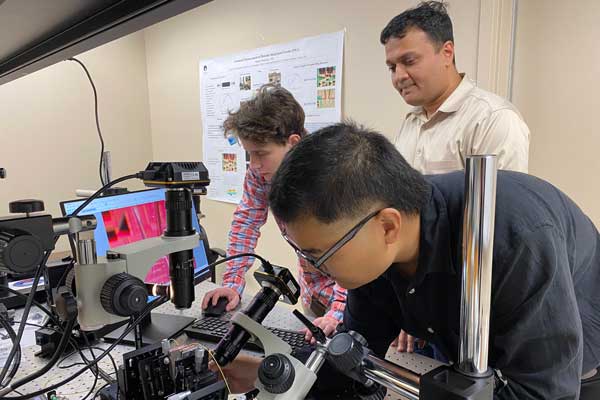News

National Science Foundation grant to help researcher develop low-cost, hand-held device to test, identify diseases, biohazards
A University of Dayton researcher will lead a nearly half-million-dollar National Science Foundation project with the goal of developing a low-cost, hand-held device to test for and identify diseases and biohazards.
“Current benchtop equipment retails for more than $100,000 and you can probably have only one in a clinic,” said Swapnajit Chakravarty, associate professor of electro-optics and photonics. “We’re trying to make something handheld, portable and commercially available right off the shelf that anyone can purchase for $100-$200.”
Chakravarty said the key to reducing cost is enabling the sensor to work using a single-wavelength laser rather than more expensive wavelength-tunable lasers.
“A single-wavelength laser is only about $50-$60. But the challenge is lining the laser up with the sensor, which can be an extremely tiny target in a device like this,” he said. “This project will help address the challenge of integrating the laser and detector on a chip, and do it on a commercial level, which will be more cost-effective than how devices typically package optics.”
While the COVID-19 pandemic demonstrated the need for this type of testing, according to the NSF abstract, Chakravarty said a device like this also could be used to identify pollutants in water, or cancers or illegal drugs by the laser “seeing” what is in a drop of blood or saliva, or someone’s breath. The sample would be placed on something that looks like a USB drive and then plugged into the portable device, he added. Results would be displayed in a few minutes.
The project will include UD graduate and undergraduate students as well as Dayton Early College Academy students who will help Chakravarty conduct the experiments. He hopes getting students involved early will help spark an interest in and eventually feed the pipeline of workers in the semiconductor industry.
“Students will be exposed to an innovation ecosystem with hands-on science and technology experience. The project will help to address the significant current need to build US-based manpower in the design and manufacturing of semiconductor chips,” according to the NSF abstract.
The University of Dayton will receive nearly $338,000 for the three-year project. Partner University of North Texas will receive nearly $160,000 and also will engage middle and high school students in Denton, Texas, in the project. Bibhudutta Rout, associate professor of physics, will lead the project at the University of North Texas.
Any middle and high schools interested in being part of the project, or anyone interested in learning more, can contact Swapnajit Chakravarty at schakravarty1@udayton.edu.
Read the NSF abstract about the project here.
For interviews, contact Shawn Robinson, associate director of news and communications, at srobinson1@udayton.edu.
